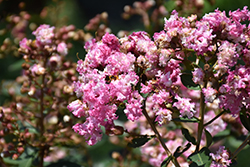It's all about ...
plants

Bicolor Crapemyrtle
Lagerstroemia 'Bicolor'
Height: 4 feet
Spread: 4 feet
Sunlight:
![]()
![]()
Hardiness Zone: 7b
Other Names: Crape Myrtle, Crepe Myrtle
Description:
This attractive, densely branched miniature selection is covered in rose and white bicolor blooms in summer, followed by deep red fall foliage; a captivating focal point for the garden or border; good disease resistance
Ornamental Features
Bicolor Crapemyrtle is clothed in stunning panicles of rose frilly flowers with white overtones at the ends of the branches from early summer to early fall. Its attractive oval leaves emerge brick red in spring, turning dark green in colour. The foliage often turns dark red in fall.
Landscape Attributes
Bicolor Crapemyrtle is a dense multi-stemmed perennial with an upright spreading habit of growth. Its relatively fine texture sets it apart from other garden plants with less refined foliage.
This is a relatively low maintenance plant, and is best cut back to the ground in late winter before active growth resumes. It has no significant negative characteristics.
Bicolor Crapemyrtle is recommended for the following landscape applications;
- Accent
- Mass Planting
- Hedges/Screening
- General Garden Use
Planting & Growing
Bicolor Crapemyrtle will grow to be about 4 feet tall at maturity, with a spread of 4 feet. Although it is technically a woody plant, this fast-growing plant can be expected to behave as a perennial in our climate if planted outdoors over the winter, usually regrowing from its base (crown) the following year. As such, gardeners should take into consideration that it will perform differently than it would in its native habitat.
This plant does best in full sun to partial shade. It prefers to grow in average to moist conditions, and shouldn't be allowed to dry out. It is very fussy about its soil conditions and must have rich, acidic soils to ensure success, and is subject to chlorosis (yellowing) of the foliage in alkaline soils. It is highly tolerant of urban pollution and will even thrive in inner city environments. This particular variety is an interspecific hybrid.
This plant is not reliably hardy in our region, and certain restrictions may apply; contact the store for more information.
